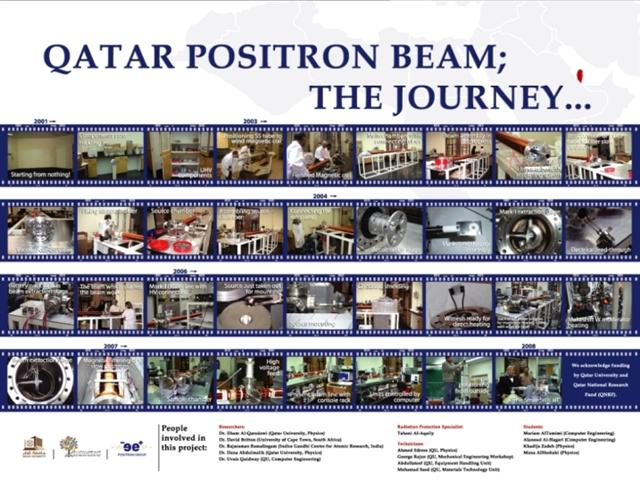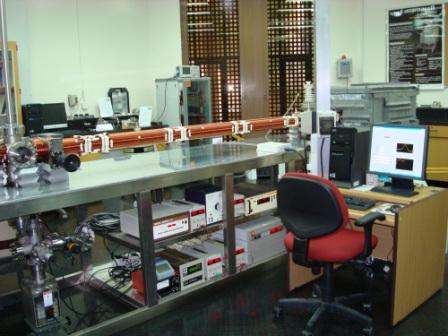Press Release
Today Qatar University reaches a major milestone by dedicating an indigenously built slow positron beam research facility to our Nation. It is the unique facility now available in the whole Middle Eastern region.

Positron is the first antiparticle discovered to exist. As per the scientific understanding of the making of the world and universe, when it was created we had both matter and antimatter. While the "matter", the present world and universe, is understandable for every one of us, the "antimatter" is not as clear. All of us know that a hydrogen atom is composed of one proton and one electron and when two of them combined with an oxygen atom they form water that we all drink and use. But the Scientific research has progressed far ahead and now we can realise anti-hydrogen by combining anti-proton and anti-electron called "positron" in two of the biggest research labs, CERN in Europe and Fermi Lab in US.
When the antimatter and matter come very close to each other, they undergo a process called annihilation. This result in the complete conversion of mass into energy. In case of positron, the antiparticle of electron, this process can be achieved in any major laboratory like ours at Qatar University using radioactive isotopes as positron emitters. These positrons when injected into any material will ultimately annihilate with electrons available inside the material. By analysing the energy released in the form of gamma rays, we can understand the physical and chemical nature of the material at atomic level (million times smaller than what our eyes can see). By controlling the initial speed of such positrons, like what we have built now, we can get crucial information from very thin layers at the surface of materials.
For example, corrosion is a major long term issue in oil and gas industries. Our positron beam facility can provide valuable information at a very early stage when the corrosion starts. Such information can complement other macroscopic analysis methods and help in screening prospective materials as well as failure analysis of the existing ones for preventive measures.
Another important area where positron beam facilities are exploited world wide is in semiconductor industries. We see the cost of all electronic goods coming down and shrinking in size as well at explosive rate. All these are made possible by packing smaller and smaller semiconductor devices. As one goes down in size imperfections or defects at atomic level become critical in device performance. Positron beam facilities provide crucial information about atomic scale imperfections so that the device processing steps are altered and qualified.
Since our positron beam facility is developed indigenously, it gives excellent base for the students to learn, experiment and excel in the fields of accelerators, antimatter and world class materials research. Developing skilled man power is crucial for our country to march towards self-sufficiency. Today we take another small step towards this goal.
Qatar University physics faculty were the main initiator of this project. The project leader Dr. Ilham Al-Qaradawi, Professor of Nuclear Physics has collaborated with several institutions world wide such as University of Cape Town in South Africa and Indira Ghandi Centre for Atomic Research to complete this project. Many students from Qatar University, Physics program have worked on this project. The project was initially funded by the Qatar University Scientific and Applied Research Centre (SARC) then by Qatar University Research Office. For the purpose of automating the whole system to be fully computer controlled collaboration has been established with Qatar university computer engineering faculty and students with funding from Qatar University and Qatar National Research Fund QNRF.
This state of the art system uses a nuclear technique to study the nanostructure of materials. It therefore emphasizes several important and modern research areas, namely; nuclear spectroscopy which is an area of high interest in Qatar and the world nowadays, material science which controls the development of technology in our world and nanotechnology, the latest advancement in science and industry.
The inauguration of this world class facility has been attended by Qatar University officials, members of the maths and physics department and many guests from education city and Qatar National Research Fund. The main role was played by the students working on several projects in the nuclear and positron physics laboratories. The students explained eagerly and enthusiastically their projects and the role they played in reaching their goals. They expressed their interest in the subject matter as well as how proud they are to do such advance research and how lucky they feel to be able to work on such modern equipment. Students working in the laboratory come from Physics program as well as from Computer Engineering at Qatar University and from medical school at Weill Cornell Medical College. They all share experiences and learn from each other. They learn how to work as part of a team and how to cooperate to reach a common goal.
The positron group has joined many collaborations world wide to provide information about advanced materials using the positron technique. They have joined world class institutions in many projects to study defects in materials. More collaborations are planned in this area of research with very prestigious institutions such as CERN. A team from Qatar will join in the Anti-hydrogen experiment at CERN very soon.
Positron Beam
In many areas of technology, material failure is a major problem. It is always related with the presence of defects, which may be either intrinsic to the material or have been introduced due to interaction with its environment during service. The latter may include fatigue due to mechanical loading, thermal cycling, or chemical interactions.
The positron beam system has been indigenously designed, constructed and brought into operation at Qatar University as a positron beam for materials science and applied physics applications.

This is the first equipment of its type in the region (the three other nearest positron beams are in Italy, South Africa and India), hence, regional collaboration with other groups working on other problems in material physics will be encouraged. To achieve this, a major aspect is the training of students in the latest techniques and the development of local expertise and a major objective will be to study problems of relevance to local industry. By meeting such a regional need, this type of facility will further open the University and the Physics program to the international scientific community.
The system has been designed and built in collaboration with the University of Cape Town in South Africa sponsored by Qatar University Scientific and Applied Research Centre (SARC), now known as the Environmental Studies Centre (ESC). At a later stage we were joined by Dr. R. Rajaraman from Indira Gandhi Centre for Atomic Research (IGCAR).
Positron Research
At the Department of Mathematics, Statistics & Physics, here at the University of Qatar, we have two lifetime spectrometers, dedicated to the study of metals and metal alloys as well as the study of polymers and semiconductors. Both spectrometers are of the 'fast-fast' type. They use plastic scintillators and are linked to computers for data acquisition.
We have studied materials of industrial importance, such as polymers, by a combination of positron techniques and other material science techniques to elucidate the effects of the size, fraction, and distribution of free volume and their influence on physical properties. Several papers have been published from this work.